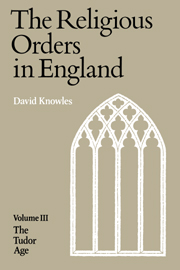Book contents
- Frontmatter
- Contents
- Preface
- List of Abbreviations
- Part One The Tudor Scene
- Chap. I The reign of Henry VII
- Chap. II Some monastic activities
- Chap. III The Cistercians
- Chap. IV The Premonstratensians
- Chap. V The friars in the early sixteenth century
- Chap. VI Sixteenth-century visitations
- Chap. VII Monastic personalities
- Chap. VIII Humanism at Evesham
- Chap. IX William More, prior of Worcester, 1518–36
- Chap. X Butley and Durham
- Part Two The Gathering Storm
- Part Three Suppression and Dissolution
- Part Four Reaction and Survival
- Appendix I Sir Thomas More's letter ‘to a monk’
- Appendix II Religious houses suppressed by Cardinal Wolsey
- Appendix III The witness of the Carthusians
- Appendix IV Houses with incomes exceeding £1000 in the Valor Ecclesiasticus
- Appendix V The sacrist of Beauvale
- Appendix VI Itinerary of the visitors, 1535–6
- Appendix VII The commissioners for the survey of the Lesser Houses in 1536
- Appendix VIII The conflict of evidence on the monasteries
- Appendix IX The last abbots of Colchester, Reading and Glastonbury
- Appendix X Regulars as bishops
- Bibliography
- Index
Chap. VI - Sixteenth-century visitations
Published online by Cambridge University Press: 08 January 2010
- Frontmatter
- Contents
- Preface
- List of Abbreviations
- Part One The Tudor Scene
- Chap. I The reign of Henry VII
- Chap. II Some monastic activities
- Chap. III The Cistercians
- Chap. IV The Premonstratensians
- Chap. V The friars in the early sixteenth century
- Chap. VI Sixteenth-century visitations
- Chap. VII Monastic personalities
- Chap. VIII Humanism at Evesham
- Chap. IX William More, prior of Worcester, 1518–36
- Chap. X Butley and Durham
- Part Two The Gathering Storm
- Part Three Suppression and Dissolution
- Part Four Reaction and Survival
- Appendix I Sir Thomas More's letter ‘to a monk’
- Appendix II Religious houses suppressed by Cardinal Wolsey
- Appendix III The witness of the Carthusians
- Appendix IV Houses with incomes exceeding £1000 in the Valor Ecclesiasticus
- Appendix V The sacrist of Beauvale
- Appendix VI Itinerary of the visitors, 1535–6
- Appendix VII The commissioners for the survey of the Lesser Houses in 1536
- Appendix VIII The conflict of evidence on the monasteries
- Appendix IX The last abbots of Colchester, Reading and Glastonbury
- Appendix X Regulars as bishops
- Bibliography
- Index
Summary
THE LINCOLN VISITATIONS
Seventy years ago, the apologist of the Tudor monks appealed to the records as evidence of the regularity of monastic life immediately before the Dissolution. At the time, few of the relevant documents were in print but nearly all have subsequently appeared. On the whole, they have proved less favourable in their verdict than Gasquet hoped, but they have also proved more difficult to interpret than he imagined. Some of their limitations as evidence have been noted elsewhere, and these must always be borne in mind. Nevertheless, they remain important evidence. In the chapters that follow, we shall review the records of the bishops of Lincoln, next those of the bishops of Norwich, and finally the shorter and more varied records of other bishops and of some of the orders concerned.
The vast medieval diocese of Lincoln stretched from the Humber to the Thames, and from the slopes of the Cotswolds to the edge of the Fenland. Besides Lincolnshire, the second largest county of England, it included the shires of Leicester, Northampton, Rutland, Oxford, Buckingham, Bedford, and a large part of Hertford. Though somewhat smaller in area than the diocese of York, it was more unwieldy for an administrator, for much of the northern diocese was barren moor, and some outlying districts were in practice all but ignored by the ordinary, while for what remained York was far more conveniently situated as a strategic centre than was Lincoln, even if the archbishop of York never resided in the city itself.
- Type
- Chapter
- Information
- The Religious Orders in England , pp. 62 - 86Publisher: Cambridge University PressPrint publication year: 1979



